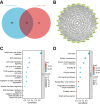Integrative bioinformatics analysis and elastic network modeling elucidate the role of cellular senescence in meningioma recurrence
- PMID: 41020919
- PMCID: PMC12480273
- DOI: 10.1007/s12672-025-03611-y
Integrative bioinformatics analysis and elastic network modeling elucidate the role of cellular senescence in meningioma recurrence
Abstract
Background: Cellular senescence is intimately tied to tumorigenesis and progression, yet its exploration in meningiomas remains inadequate. In this study, we aim to unravel the role of cellular senescence-associated genes (CSA-genes) in meningioma recurrence and identify potential diagnostic markers and therapeutic targets.
Methods: We analyzed GSE136661 and GSE173825 datasets to identify CSA-signature genes through differential expression analysis, weighted gene co-expression network analysis, protein-protein interaction network construction, and elastic net regression modeling. Functional enrichment, immune cell infiltration using CIBERSORT, and transcription factor prediction were performed. Potential drugs were screened using Enrichr database.
Results: A total of 1827 differentially expressed genes (DEGs) were identified, among which 48 were cell senescence-associated differentially expressed genes (CSA-DEGs). Four key CSA-signature genes (CDK1, FOXM1, MYBL2, and BIRC5) were discovered by integrating elastic net regression and network algorithms. The elastic net model demonstrated strong classification performance with an area under the curve (AUC) of 0.816 in distinguishing recurrent meningiomas. Recurrent tumors exhibited significant immune heterogeneity, including increased neutrophils and M0 macrophages (p = 0.007), and CSA-genes were significantly correlated with immune infiltration and checkpoint molecules such as VSIR (p < 0.05). Transcription factor E2F1 was identified as a potential regulator of CSA-signature genes. Drug screening highlighted Dasatinib and Rapamycin as promising candidates with notable anti-meningioma potential.
Conclusion: Our findings highlight crucial genes and pathways in meningioma recurrence, introducing novel therapeutic candidates. These findings pave new avenues for further elucidating meningioma recurrence mechanisms and developing innovative treatments.
Keywords: Cellular senescence; Elastic net; Immune infiltration; Meningioma recurrence.
© 2025. The Author(s).
Conflict of interest statement
Declarations. Ethics approval and consent to participate: Not applicable. Consent for publication: Not applicable. Competing interests: The authors declare no competing interests.
Figures







References
-
- Materi J, Mampre D, Ehresman J, Rincon-Torroella J, Chaichana KL. Predictors of recurrence and high growth rate of residual meningiomas after subtotal resection. J Neurosurg. 2021;134:410–6. - PubMed
-
- Gousias K, Schramm J, Simon M. The Simpson grading revisited: aggressive surgery and its place in modern meningioma management. J Neurosurg. 2016;125:551–60. - PubMed
LinkOut - more resources
Full Text Sources
Research Materials
Miscellaneous
